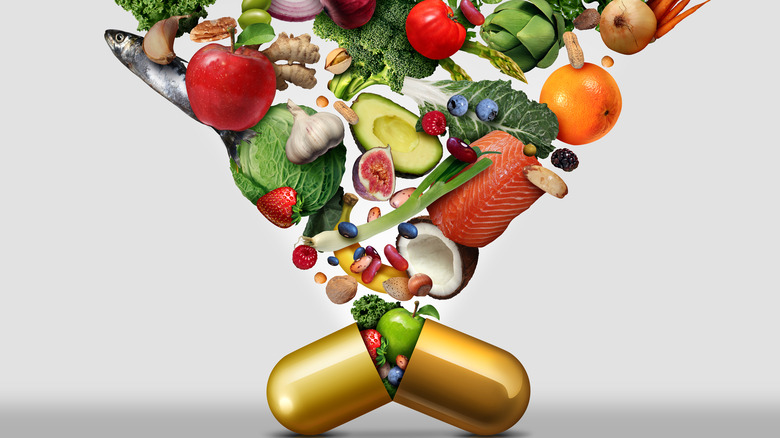Vitamins From Food Versus Supplements: Which Is Best For You?
While we're caught in the throes of our busy lives, the thought that we would have the time to plan and prepare well-balanced and nourishing meals can seem almost laughable. Luckily, we exist in an era where there's a pill for almost everything. All we have to do is pop a multivitamin, and it takes the pressure off meal time, right?
Vitamin supplements saw their beginnings in the mid-20th century, once clinicians deciphered which vitamins our bodies needed to function properly and how to synthesize them (per Stratum Nutrition). From that point, they began working toward what we now recognize as the multivitamin to address a wide range of health problems. As the agricultural industry evolved between the 1970s and 1990s and prepackaged foods became the norm in grocery stores, the general public saw a striking decrease in the nutritional content of their food — and vitamin supplements were there to fill the void. To this day, we continue to try and use supplements as a way to obtain better health. In 2022, vitamin and supplement manufacturers pocketed $37.2 billion (per IBIS World).
But can vitamin supplements really take the place of the vitamins we get from food? Let's take a closer look.
Vitamins from food vs. supplements
When we include supplements in our daily regimen, there's no denying that it increases our total nutrient intake (per Medical News Today). However, supplements were designed to be just that — supplemental. The Mayo Clinic explains that there are a number of reasons that vitamin supplements can't take the place of nutritious whole foods like fruits and vegetables.
For one, whole foods are more dynamic and complex, offering a wide range of micronutrients that can't be replicated in a pill. They also provide our bodies with antioxidants, which protect our cells and tissues from damaging free radicals. And when we take supplements in lieu of eating our fruits and veggies, we miss out on all of that deliciously essential dietary fiber, which not only keeps our bowel movements regular, but can also reduce the risk of type 2 diabetes, stroke, heart disease, and colorectal cancer.
To back this up, a 2018 study published in the Journal of the American College of Cardiology found that multivitamins, vitamins C and D, calcium, selenium, and beta carotene supplements had no effect on cardiovascular health outcomes, while some others actually increased the risk of mortality. They report that folic acid and B vitamins could be beneficial for stroke and heart disease, though the evidence was deemed "moderate- or low-quality."
How to incorporate more vitamins during meal time
If we want to truly nourish our bodies, it starts and ends with the food we feed them. And while seeking out and cooking vitamin-rich meals can feel like a daunting task, we're here to help make it a little easier.
According to the U.S. Department of Agriculture, the typical American isn't getting enough calcium, vitamin D, potassium, or fiber, listing them as "nutrients of public health concern." To increase your calcium intake, try eating more yogurt, milk, cheese, salmon, sardines, oatmeal, white beans, and spinach (per Familydoctor.org). Fatty fish like salmon and canned tuna can provide your body with the vitamin D it needs, just like fortified milk, yogurt, or orange juice. If you're lacking in potassium, bananas, sweet potatoes, white potatoes, beans, tomato products, peaches, and fish like cod, halibut, and yellowfin tuna are great options. For more magnesium, reach for pumpkin, beans, spinach, artichokes, nuts, brown rice, or tofu. As for fiber, UCSF Health says to include at least one whole-grain item in every meal, as well as eating lots of high-fiber fruits, vegetables, and legumes like cauliflower, raspberries, apples, and peas.



